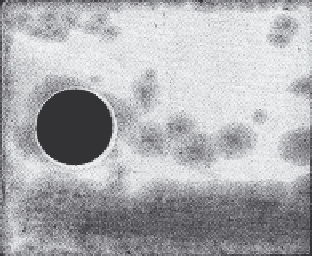Environmental Engineering Reference
In-Depth Information
5
4
3
4.44
Patch oxide formation on Zircaloy-2 after an exposure of 8.5
×
10
21
n/cm
2
,
E
> 1 MeV. The oxide is thinnest at uniform black oxide (5)
and patch oxide (4) and is thickest at coalesced patches (3). (Source:
Reprinted, with permission, from Huang
et al
. (1996), copyright ASTM
International, 100 Barr Harbor Drive, West Conshohocken, PA 19428.)
thin, about the same as the black uniform corrosion fi lm. At some point the
patches cover 100% of the surface and oxide thickening occurs at an accel-
erated rate, labelled 'late increased corrosion' in Fig. 4.43.
Importantly, at the same or somewhat higher fl uences, a marked increase
in hydrogen pickup fraction occurs. This hydriding is potentially a more seri-
ous issue than the corrosion increase and is discussed later.
Figure 4.45 gives optical micrographs and schematics of various types of
corrosion. Schematics A and C show normal and increased uniform oxide,
and the others illustrate nodular corrosion. Zr-Nb alloys and small-SPP
Zircaloys (average SPP size less than about 0.1 µm) in general do not form
nodules. In large-SPP Zircaloys, nodules initiate early in life and grow at a
decreasing rate with fl uence. In some cases, for aggressive water chemistries
and susceptible material, nodules can coalesce to cover the entire surface.
Nodular oxide thickness does not generally cause performance problems;
however in severe cases spalled oxide can be a source of 'grit' in control
drive mechanisms. Serious fuel failure problems can be induced by a combi-
nation of heavy nodular corrosion and copper-zinc-laden crud, resulting in
the crud-induced localized corrosion (CILC) phenomenon discussed later.
Susceptibility of Zircaloys to in-reactor nodular corrosion can be identi-
fi ed by laboratory high temperature steam tests. The most effective testing
procedures are variations of the 'two-step test' described by Cheng
et al
.
(1987) where Zircaloys are exposed to steam at 410°C/1500 psi (683K/102
bars) for 8 h followed by 510°/1500 psi (783K/102 bars) for 16 h. In such
tests, Zr-Nb alloys do not exhibit nodular corrosion.
The fi fth type of corrosion, indicated in Fig. 4.43, is so-called shadow cor-
rosion, described in more detail later. Shadow corrosion is induced on all
zirconium alloys when they are in close proximity to many non-zirconium

Search WWH ::

Custom Search